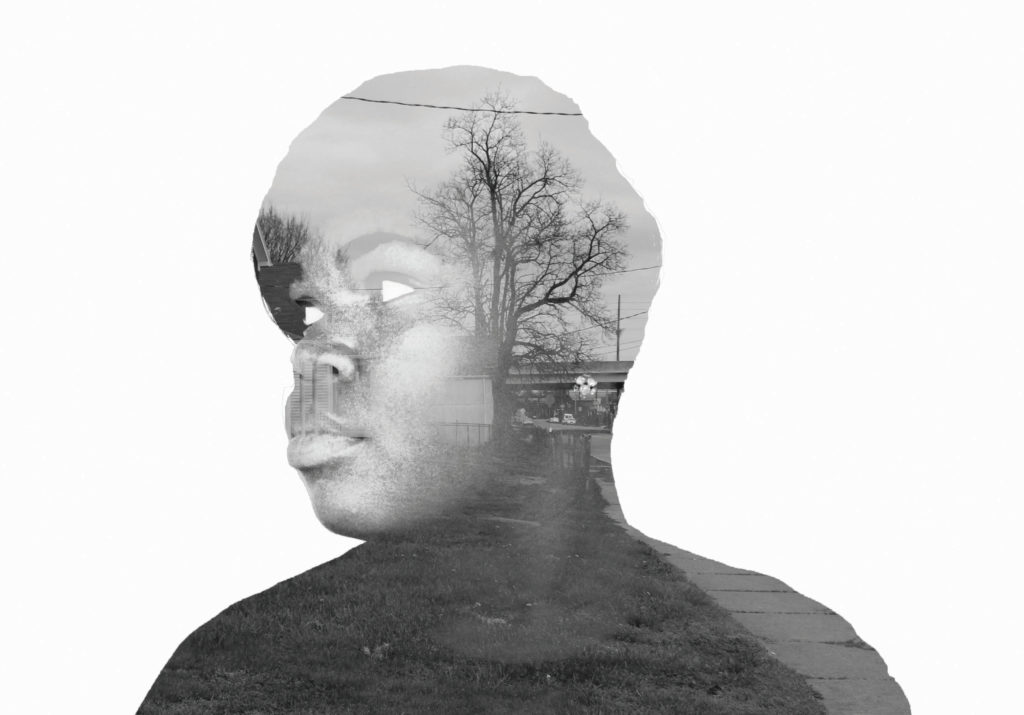The low, methodical thump of R&B music pulsed through 17-year-old Ke Ke White’s headphones as she walked south down the sidewalk parallel to Hubbards Lane towards Mall St. Matthews. As the African-American high school senior stepped away from Waggener High School and onto the sidewalk she noticed something.
Passing eyes that should have been concentrating on the road flickered up and focused on something else — her.
“When a car goes by, they will look at me and be like, ‘What is she doing here?’” White said.
The feeling of being watched isn’t new to White; the sensation routinely surfaces when she goes into the stores and restaurants near her school. But she only notices glimpses when she’s in one area of town: the East End.
On a list compiled by the financial news company 24/7 Wall Street, Louisville ranks fourth of the nine most segregated cities in America. The separation of ethnicities, and different levels of wealth, has existed in Jefferson County for decades; however, the list only takes into account Louisville’s residential division. The distribution of students in Jefferson County Public Schools tells a much different story.
White does belong in the East End, at least, according to the JCPS student assignment plan. In an attempt to blur the socioeconomic lines of Jefferson County, JCPS has placed White at the satellite school of Waggener to add diversity to the predominantly Caucasian East End.
As the largest urban hub of Kentucky, Louisville has a much higher percentage of minorities than the rest of the state. According to the 2010 census, the white population made up 72.7 percent of the total population, the black population made up 20.8 percent, Latinos made up 4.4 percent, and Asians made up 2.2 percent. Whites are 87.8 percent of Kentucky’s population, while blacks — Kentucky’s second largest ethnic/racial group — make up only 7.8 percent of the state’s population.
Like any other major Southern city organized before the Civil War, the layout of 1800s Louisville reflected the slavery and servitude present at the time.
“Whites wanted African Americans living near them to provide service,” said Dr. Cate Fosl, Director of the Anne Braden Institute for Social Justice Research at the University of Louisville. “That brought about what’s called a layer-cake pattern of growth as a city. You might have a block that’s all white, but starting maybe even in the alley, you’d have a block that was all black. They were the servants of the whites, but they were also their neighbors.”
The area that is now known as the West End was once a center of Louisville’s wealthy and elite. The slaves, and later paid servants, lived near this area of town because they were needed at the homes of affluent Louisvillians.
Ironically, Louisville and its West End became more segregated after legislators enacted laws intended to make housing fair on a local and national level. Legal measures to encourage residential integration, like the Fair Housing Act of 1968, culminated in what is now known as “white flight.”
White flight was the movement of white people from more diverse urban areas to the homogeneous suburbs. This was the time that the white population of West Louisville made their exit to the outskirts of the county.
“What happened is that unfortunately just after African Americans had achieved a widespread law supporting their right to open housing, so many whites made a mass exodus out of West Louisville,” Dr. Fosl said. “So most whites think about West Louisville as all black, which it never has been and still isn’t today. But there was certainly a much higher black concentration after 1966 than there ever was before in Louisville’s history.”
This 1960s departure marks the birth of the Ninth Street divide, with Ninth Street signifying the entrance to West Louisville. To some, it’s an area that seems undesirable.
Haley Wachter is a white junior at Eastern High School and resident of Middletown, both in the East End. While Wachter has lived in Louisville her entire life, she has never been beyond the dividing line of Ninth Street.
“I’ve just never really had a need to go to the West End,” Wachter said. “Not to fall into stigmas, but on the news you hear about a lot of violence and crime coming from the west end of town, and if there’s not a reason to go there, you don’t want to.”
Even though Louisville is more diverse in 2016 than it ever has been, residential areas are still segregated. However, JCPS and the legal system have taken steps to make Louisville’s public schools more integrated.
In 1975, the Supreme Court ordered school districts to institute a student assignment plan to desegregate their schools. Busing was the chosen method — a system of forced integration in which students are transported to schools in different neighborhoods than their own. While busing was a federal decision, the court placed the burden of implementation upon individual cities and school systems.
Because of white flight, neighborhood schools had become separated in a new way: de facto segregation. In the 1954 case Brown v. Board of Education, the Supreme Court ruled that “separate but equal” was unconstitutional and inherently unequal, effectively ending de jure, or legally enforced, segregation in schools. De facto segregation had the same effect of separating races, but it’s caused by the preferences of individuals, self-determined by different types of people. Hence, busing provided schools with a more effective way to desegregate, even with residential segregation in play.
Jefferson County Public Schools (JCPS) was one of the districts ordered to desegregate, but instead of being race-based, the current school assignment plan is based off of Louisville’s changing income levels, housing patterns, and population.
In 2007, the Supreme Court case, Parents Involved in Community Schools v. Seattle School District No. 1, dictated that schools couldn’t use the individual race of a student to determine their placement in a school. One of the school districts impacted was JCPS.
“When that court order came, the Jefferson County school board reconvened, and they determined that having diversity in schools is important, and it’s beneficial for the students because it offers them real world experiences,” said Barbara Dempsey, the Director of JCPS Student Assignment.
Of the 22 high schools within the JCPS district, 16 reserve space for “resides students,” or students who are automatically admitted to the school based on address. The five schools that are application-only are Brown, Butler Traditional, Central, duPont Manual, and Louisville Male.
Application-only schools and magnet schools are a way to incentivize integration across the district. Magnets are programs which offer classes that are specialized for certain career tracks; they offer skills that range from performing and visual arts to vocational programs. To get into a magnet, one must apply, even if it is at their home school.
“Magnet schools are called magnet because they attract students from other areas, and so we have found magnets provide a lot of natural diversity,” Dempsey said. “They provide a lot of choice and opportunity for students to diversify.”
If a student does not apply to a magnet, he or she is automatically placed at a “resides” or “home” school, which is not necessarily the school that is located closest to him or her. The school district is organized into “resides areas,” clusters of neighborhoods that contain multiple schools that students in those areas can attend. Resides areas usually correspond to the nearest school, but in an attempt to diversify schools, JCPS implemented satellite areas. The students from satellite areas represent a different demographic class than the schools to which they are assigned.
“If it was just East End kids, our school would lose a lot of diversity, and that’s why they let other people come from different parts of town,” said Wachter. “I don’t think diversity or any lack thereof has contributed to my academic experience, but it has changed some of the school’s culture.”
White lives in a satellite area surrounding Shawnee High School in the West End, but her resides school is Waggener — a 13-mile drive to the East End’s St. Matthews neighborhood.
“I like going to Waggener because I like the different types of people I’ve met, but I would rather go to a school closer to me,” White said. “Living so far away limits my after school activities because I work a lot, and because it’s hard to ride the TARC.”
The culture of Waggener, with its diverse students and magnet tracks, is something White wishes could be replicated in her own neighborhood. Waggener itself is not the problem for her, it is the distance between her home and her school.
If White needs to stay after school for an activity, like step team, she must ride the TARC bus home, which could take over an hour. Public buses can serve as the primary transportation for teens who either cannot drive or do not own a car. Transportation to the schools can also prove difficult for parents.
Parent Teacher Associations (PTAs) are a way for schools to supplement money for programs that might not be covered by funding from JCPS. PTAs are also a way for parents to participate in their child’s education and have a direct connection with the administration at their child’s school. Living far away from a school can deter many parents or students from participating as actively as possible.
“PTAs and alumni associations are very important to public schools,” said Allison Martin, JCPS Director of Communications. “They help provide additional programming and equipment to schools that assist with teaching and learning.”
State funds, property taxes, and occupational taxes from across the county are collected by JCPS and distributed to schools based on a formula regarding the school’s population and staffing needs.
Although living far away from a school can present challenges, some JCPS schools have taken the initiative to mend the gap between parents and teachers.
On March 10, 2016, rather than holding all parent-teacher conferences at school, Westport Middle School held half of its parent-teacher conferences at the Table Cafe, a coffee shop in the Portland neighborhood. While Westport is in the East End, almost a third of its population are satellite students from Portland in the West End. According to WDRB, Principal Jodie Zeller worked with the school’s PTSA to “bring the school to the community.”
The teachers at Westport did this of their own volition — not as a directive from JCPS to organize a satellite location for parent-teacher conferences. Nor was there financial compensation. Yet this model is something JCPS is working toward, according to Martin.
“In addition to off-site conferences, our school system is working to take the school application process into neighborhoods,” Martin said. “We have a mobile application bus that travels to neighborhoods to give students more access to the educational choices available within the school district.”
As a policy researcher, Dr. Fosl believes that the JCPS school assignment plan should continue because of the positive impact it has had on desegregating the school system. That being said, she also recognizes the plan’s faults, like long bus rides and far distances from home to school. She said there should be complementary policies to desegregate housing in Louisville.
“For two generations or more, we have had the experience of going to school together. There is value in that. There is diversity and tolerance in that,” Dr. Fosl said. “Blacks and whites go to school together in Jefferson County. They just do.”
For now, White feels relief when returning from Mall St. Matthews to her school’s double doors. There are no lingering stares, no raised eyebrows. Though Waggener is not in her neighborhood, is a place White feels she belongs. It’s where she wants to be.













Ula Frusciante • Aug 5, 2016 at 9:39 pm
I do like the manner in which you have framed this specific challenge plus it really does present me personally a lot of fodder for thought. However, coming from what I have seen, I just hope as other responses pile on that people remain on issue and not start upon a soap box involving some other news du jour. Yet, thank you for this excellent point and whilst I can not really concur with this in totality, I value the viewpoint.
marvel contest of champions hack download • Jul 11, 2016 at 6:39 am
Thank you for giving the info. It will help me lot.